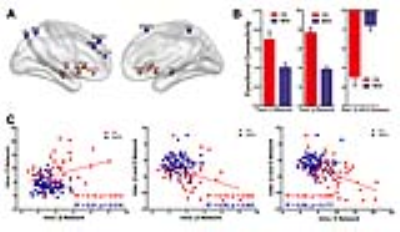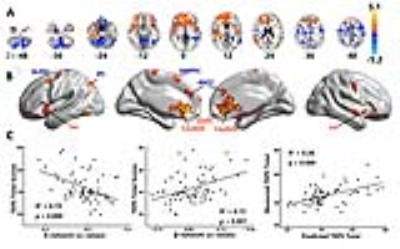5299
Disrupted reward and cognitive control networks contribute to anhedonia in depression1Neurology, Southeast Uninversity, Nanjing, China, 2Neurology, Southeast University, Nanjing, China, 3Xinxiang Medical Colleage, Xinxiang, China, 4Southeast University, Nanjing, China
Synopsis
In the present study, we investigate the association between intrinsic reward network (β-network) and cognitive control network (δ-network) and anhedonia in depression patient. We found that depression patients showed decreased functional connectivity (FC) in intra- and inter- β- and δ-networks and the FC in both β- and δ-networks were significantly correlated with anhedonic severity in depression patients. Importantly, the integrated neural features of β- and δ-networks would more precisely predict anhedonia symptom. These findings indicated that the neural features in both β- and δ-networks would represent a fundamental mechanism underlying anhedonia in the MDD patients.
Introduction
Neuroimaging studies have identified that anhedonia, a core features of major depressive disorder (MDD), was associated with dysfunction of reward processing. According to McClure et al.’s dual-process theory of reward, there are two separate neural networks in the reward process of human brain: the brain regions in reward network (β-network) for primary reward and the brain regions in cognitive control network (δ-network) for secondary rewards.1,2 Recent evidences also suggested the reduced cognitive control might attribute to one of the important factors in depression and been consistently linked with the onset and maintenance of depression (Disner et al., 2011; Ebmeier et al., 2006).3,4 However, it is still not clear how the reward network (β-network) and cognitive control network (δ-network) are linked to biasing anhedonia in MDD patients.Methods
Sixty-eight MDD patients and 64 cognitively normal (CN) subjects were underwent a resting-state functional magnetic resonance imaging scan. 2*2 ANCOVA analysis was used to explore the difference of nucleus accumbens-based voxel-wised functional connectivity (FC) between groups. Then, the β- and δ-networks were constructed and compared the FC intensity within and between β- and δ-networks across all subjects. Multiple linear regression analysis was also employed to investigate the relationships between neural features of β- and δ-networks and anhedonia in MDD patients.Results
Compared to CN subjects, MDD patients showed the synergistically functional decoupling in both β- and δ-networks, as well as the decreased FC intensity in intra- and inter- β- and δ-networks. Also, the FC in both β- and δ-networks were significantly correlated with anhedonic severity in MDD patients. More importantly, the integrated neural features of β- and δ-networks would more precisely predict anhedonia symptom.Conclusion
These findings initially demonstrated that the imbalanced β- and δ-networks activity successfully predicted anhedonia severity, and suggested that the neural features in both β- and δ-networks would represent a fundamental mechanism underlying anhedonia in the MDD patients.Acknowledgements
This work was supported by the National Key Projects for Research and Development of MOST (2016YFC1305800,2016YFC1305802), National Natural Science Foundation of China (30825014, 30971016, ZJZ; 81171323, 91332118, 81672756, CMX; 81371488, HXZ ) and Major International Joint Research Project (81420108012, ZJZ).References
1 McClure SM, Laibson DI, Loewenstein G, Cohen JD: Separate neural systems value immediate and delayed monetary rewards. Science 2004;306:503-507.
2 McClure SM, Ericson KM, Laibson DI, Loewenstein G, Cohen JD: Time discounting for primary rewards. The Journal of neuroscience : the official journal of the Society for Neuroscience 2007;27:5796-5804.
3 Ebmeier K, Rose E, Steele D: Cognitive impairment and fMRI in major depression. Neurotox Res 2006;10:87-92.
4 Disner SG, Beevers CG, Haigh EA, Beck AT: Neural mechanisms of the cognitive model of depression. Nature reviews Neuroscience 2011;12:467-477.


